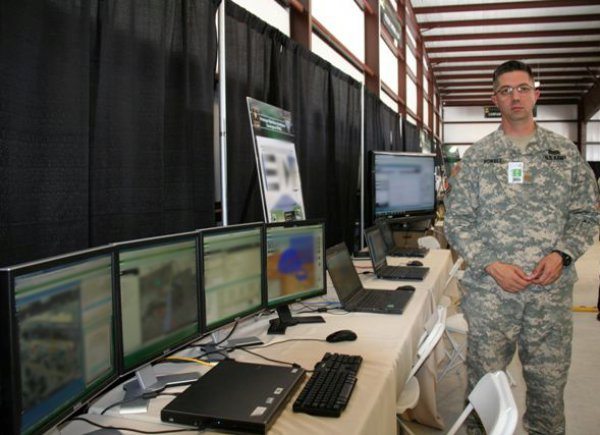When the Army unleashed its goal to fuse real-time intelligence with combat operational data, it had one overall objective: to ensure the commander possessed a comprehensive picture of the battlefield.
Termed Prototype-Operations/Intelligence Convergence, or P-OIC, or OPS/Intel convergence, this initiative has achieved significant advances in recent months.
“Combining data from the operational environment with the data from the intelligence community provides the commander with increased situational awareness to plan and adjust the mission,” said Maj. Ryan Howell, Assistant Program Manager, Project Manager Mission Command, or PM MC, Command Post Computing Environment, known as CP CE, under Program Executive Office Command Control Communications-Tactical, or PEO-C3T.
The first phase of OPS/Intel convergence has come to fruition via the combined efforts of PM MC and PM Distributed Common Ground System-Army, or DCGS-A. PM MC’s suite of products provides a collaborative computing environment for real-time shared situational understanding. DCGS-A, assigned to the Program Executive Office for Intelligence, Electronic Warfare and Sensors, known as PEO IEW&S, is the Army’s primary system for processing and disseminating collection elements of reconnaissance, surveillance and intelligence operations.
The key software product for OPS/Intel is DISA’s Ozone widget framework, which is a government-owned product that enables rapid third-party application or “apps” development to produce web-based capabilities for Soldiers and commanders.
“This common framework is crucial to OPS/Intel convergence,” Howell said. “It provides the commanders with a complete Common Operating Picture, or COP, viewable through apps that provide three-dimensional views for operational and intelligence awareness for ground and air reporting, field artillery commands, logistics, alerts and incident reporting.”
To view these apps, users employ Command Web, the web-enabled environment that provides COP data and collaborative tools for those who do not possess thick client (full-featured computer) hardware capabilities. Developers can create the apps on the common framework, similar to how apps are developed on smartphones.
OPS/Intel was demonstrated by Soldiers at the recent Network Integration Evaluation, or NIE, 12.2 held at White Sands Missile Range, N.M. The NIEs are semi-annual field exercises designed to rapidly integrate and mature the Army’s tactical communications network.
Howell’s team also provided a successful demonstration of OPS/Intel to U.S. Army staff at the Pentagon, which in addition to showing how the common framework could run apps, illustrated potential cost savings for the Army.
“We also demonstrated that not only can we put Mission Command applications on both Mission Command and DSGS-A hardware, we can put Mission Command and DSGS-A virtual machines on third-party PEO-provided hardware,” said Howell. “In other words, when a unit receives the new Command Post COE software, the operators can reuse equipment already provided regardless of which organization originally purchased that equipment.”
Maj. Gen. Tony Cucolo, G8 Director of Force Development; Col. Anthony Williams, G8 Force Development Integration; Col. Robert Carpenter, director, Mission Command ASA(ALT); along with representatives from the Army Geospatial Center, PM DCGS-A, G2, G3/5/7 and G8, comprised the Pentagon audience.
“I’m so far favorably impressed,” said Williams. “This is the right path forward, and an Ozone widget-type framework is where we want to take our efforts with COE and CP CE.”
Williams was referring to the Army’s Common Operating Environment, or COE, which is an approved set of computing technologies and standards that enable secure and interoperable applications to be developed rapidly across several defined computing environments.
He said he understood the challenges of working across multiple PM shops to develop sophisticated technology and was impressed with the progress on the initiative and demonstrated teamwork.
PM MC and DSGS-A continue to enhance the OPS/Intel capabilities.
“We are nearly ready to run a complete scenario that incorporates mission receipt, hasty mission analysis, orders distribution, mission execution and reaction to activities incorporating new Intel during mission execution to the extent the current available widgets allow,” said Howell.
Howell said the future evolution of command post systems will mature into primary service being delivered by Ozone applications, across operations, intelligence, airspace management, fires, sustainment and others, with minimal robust stand-alone systems to support disconnected, intermittent and latent requirements.
“This feature will provide users with enhanced situational awareness because they will be able to seamlessly operate the apps should a network outage occur,” said Howell.
Col. Jonas Vogelhut, Program Manager for PM MC, is pleased with the OPS/Intel initiative’s progress to date.
“Ultimately, the convergence of operations and intelligence capabilities into a common visualization will enable better decision making for commanders, leading to enhanced mission command,” he said.










